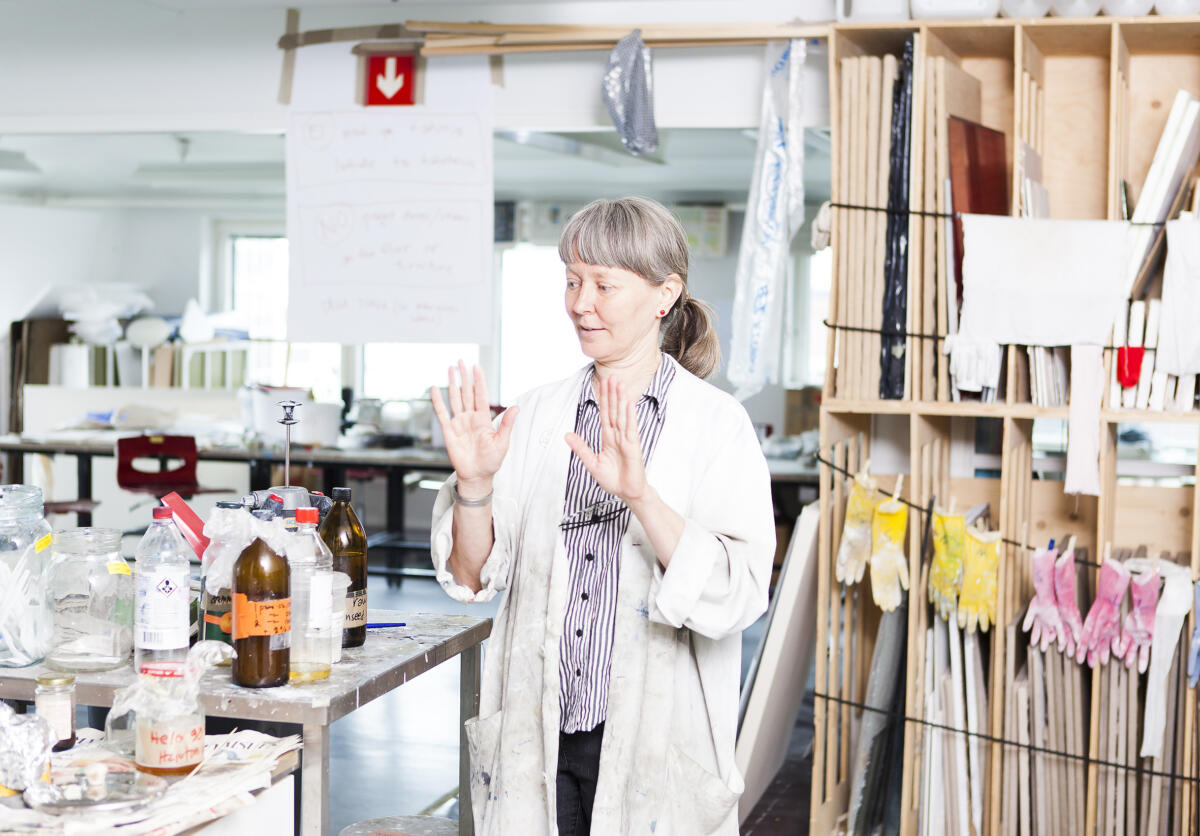Malla Tallgren’s lessons in material studies provided a basis for hundreds of visual artists
Malla Tallgren, who worked as a lecturer in material studies at Uniarts Helsinki’s Academy of Fine Arts for three decades, thinks that material studies are like the grammar of a language for artists. Now, she will enter a new, freer stage of life after retiring.

Tallgren’s versatile background as a chemist, painter and art restorer made her lessons in material studies gems that provided hundreds of painters a valuable basis for their own artist careers and that are widely esteemed also in the international fine arts scene. Tallgren’s guiding principles in material studies are reflected on works that are featured in the Kuvan Kevät MFA exhibition as well as in research in fine arts.
You have worked for over three decades at the Academy of Fine Arts – how would you describe this time period?
The Academy of Fine Arts was a turning point in my career. My quiet and lonely job as an art restorer turned into managing hustle and bustle in a social setting. Even though the job was straining and involved responsibility, I feel like I’ve pursued my professional calling, and teaching is something that I’ve enjoyed tremendously. The institution around me has changed from a small art school to a big one, but I’ve had the opportunity to do my work in peace. I’ve always had good facilities and working conditions. I’ve felt useful and it has seemed that my teaching has benefited students. I’ve been supported by the artist community.
You have developed a course unit called material studies, what set the ball rolling?
It all started already in my childhood, really. My father was a material chemist, so ever since I was a kid, I’ve observed material phenomena. I studied to become a painter and an art restorer, and I’ve also completed additional studies in chemistry. When I started at the Academy of Fine Arts, there were hardly any material studies available. Gradually, the academy started offering more theoretical studies and gave me the space and responsibility to develop the studies further. Eventually, material studies expanded into a full one-year course unit. Right from the beginning, my idea was that anyone can do what they want in their art, but I want to tell the reason. The reason why you apply glue on a canvas, for example. The starting point was reflecting on the kinds of things that needed to be considered when using different materials. I made changes in the course depending on the kinds of needs and feedback that emerged from people in the art scene. It was also pivotal that the course found its form before the internet, so all teaching was based on literature.
It’s said that your teaching is reflected on the paintings featured in the Kuvan Kevät exhibition. What have been your key lessons for young visual artists?
I think that material studies are like the grammar of a language for artists; a language determining how we think. Material studies delve into our sense of touch and smell and into chemistry. These studies are an important source of support and help for an artist. Even though times and art around us change, material studies, which are based in natural sciences, stay the same. It’s really important to give lectures on theoretical aspects so that students understand the chemical fundamentals of art, for example the various features of pigments.
Even though many things have changed over the decades, students have stayed similar in a certain way. Students are maybe a bit more compliant nowadays. Before, students tended to question things more and some of them insisted on using the cheapest wood glue they found in the hardware store for priming their canvases. There was quite a lot of this kind of questioning at the start, which was good. I had to learn how to defend my choices and how to pass on my knowledge to students. The responsibility over material choices is an important learning opportunity for an artist. Without information, you can’t choose for yourself, and you’re limited to fewer options where someone else determines the methods.
What does ecological sustainability mean to you from the perspective of art-making?
Instead of ecological sustainability, I would like to highlight the history of art and techniques that have used for centuries or thousands of years. Everything is based on natural materials, and those same materials can still be used for making art. Besides having an understanding of history, it’s also very important to have an understanding of materials, and the nature offers us so many possibilities. We just need to know how to take advantage of them. There’s no finer material than linseed oil, for example. It meets all the criteria, and it can be broken down into chemical components. It’s inspiring how inventive humans have been.
To put it simply, you could say that natural materials are sustainable and compostable, unlike plastic-based materials. Back in the day, I made all the possible tests, and I’ve learned how to verbalise the way these things are taught in a timely manner. The very first thing I teach is to clean the brush in a way that prevents toxic substances from ending up in the sea through plumbing.